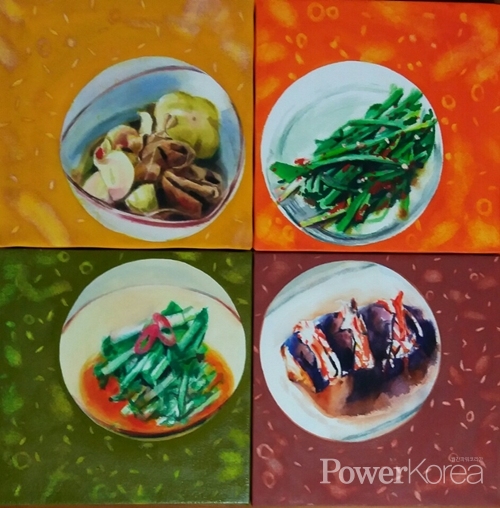 |
Artist Song Bo-yung is famous for painting kimchi, a staple in Korean cuisine. When asked why kimchi, she answered it was her attachment to her mother. She added lactobacillus in kimchi could not be seen with our eyes but we had felt it for a long time through the love of our mothers and it is intangible gift to us all and a means of communication and sympathy. PowerKorea met Song.
Q. Why kimchi inspired you?
A. I’m the fourth among 2 sons and 5 daughters. We lived in a tile-roofed house and the back garden was full of crocks for kimchi, soy sauce and other condiments. When winter was nigh, my mother prepared a variety of kimchi to feed us as well as her and my father’s family gatherings. I remember my mother often working around the crocks during my elementary years. She passed away and now I feel I understand what she might have felt. So kimchi for me is attachment and absence.
Q. What made you paint kimchi?
A. I painted time to time for hobby. Then I became serious and wanted to express the attachment and absence on the canvas. One day I was having a meal and the kkakgugi – diced radish kimchi – surged into my heart like a wave and I felt solaced. I thought if can feel solaced by watching kimchi, others might also feel the same. So I started painting kimchi from then on.
 |
Q. What about lactobacillus?
A. As I develop my idea on kimchi and my painting, my thought naturally reached to lactobacillus. I thought it might be a good idea to use lactobacillus as an artistic subject. There are different colors of lactobacillus though we cannot see with bare eyes. I connected this invisibility with the attachment and absence and painted it like they are symbols of mother’s love and care. My first solo exhibition at La Mer Insa-dong, Seoul, actually was themed on lactobacillus and kimchi.
Q. How do you observe reactions of appreciators?
A. At my first solo exhibition, some people asked me whether they are photos. So I tend to avoid too hyper-real nowadays. If you see carefully, you can find pressing stone on my works. A child asked one day what it was. While explaining, I felt I was communicating of the past and the present. It took me by surprise that kimchi is an intangible asset and it made me feel that it might become a history one day and people might see how kimchi looked like in the past. So I thought the more kimchi paintings the better.
 |
Q. What are the charms of kimchi painting?
A. I feel much attached to tradition. And kimchi represents Korean-warmness very well. Kimchi has been an invisible member of all Korean families for a long time. It has been a symbol of Korean way of sharing with neighbors. Back in the days, many Koreans were happy with a piece of kimchi and a bowl of rice. There are many stories accompanying kimchi if we try to know. It is a simple food but has rich memories.
Q. Lastly, tell us about future plan.
A. I want to run a kimchi museum where people can see it on painting or other means of art. Meanwhile, I will actively engage in exhibitions. I recently finished an invitational exhibition at Jail Dental Clinic in Nonsan City and am set to hold ‘Long Live Kimchi Exhibition’ at Jangsu Gallery, Jeolla Province, from November this year. Come and see.
지윤석 기자 jsong_ps13@naver.com







